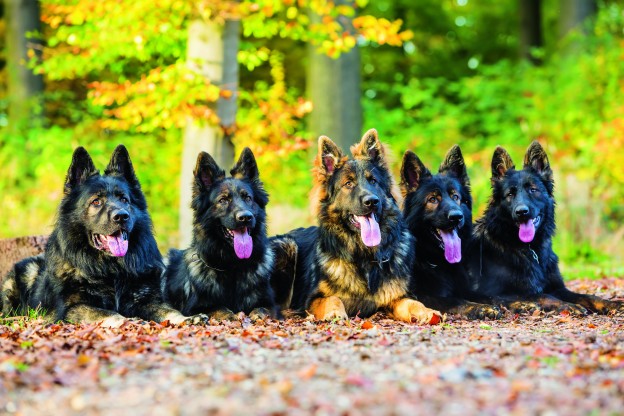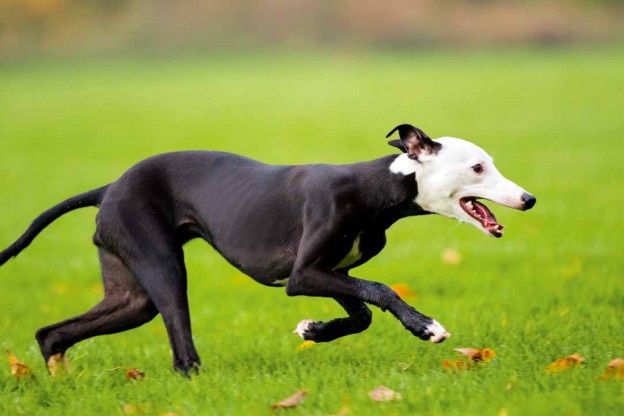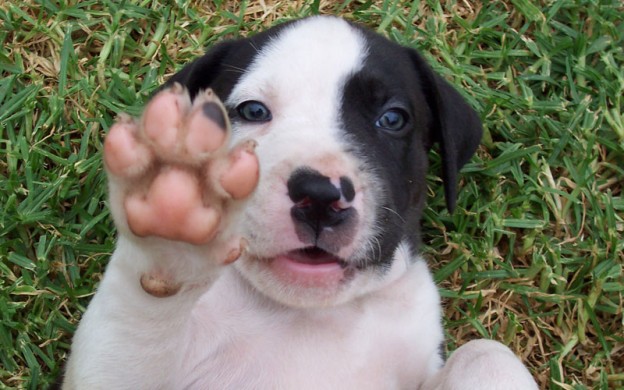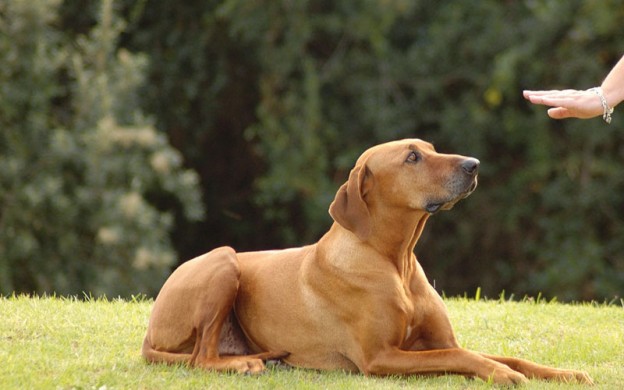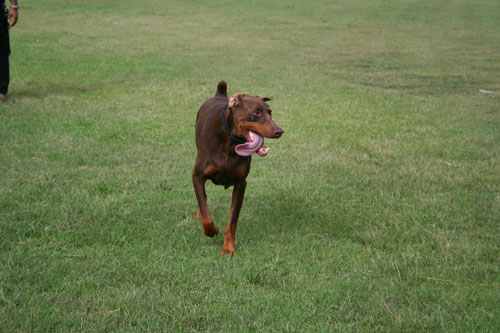
Are dog parks good for all dogs all of the time? Delta behavioural trainer Karin Larsen Bridge, from Get S.M.A.R.T (Successful Motivation And Reward Trained) Dogs, looks at the pros and cons of the off-lead dog park and if its right for you and your dog.
When off-lead dog parks first started appearing several years ago, they were heralded as a major advance toward a better quality of life for our pets. Dogs cooped up in apartments or left alone all day could enjoy a vigorous romp with other dogs in a council-approved canine kingdom.
Why visit an off-lead dog park?
Thousands of dog owners visit dog parks every day for many obvious reasons. Dog parks can provide:
- opportunities for dogs to socialise unrestricted with a variety of other dogs and people
- an easy way for busy people to provide a degree of physical and mental stimulation for their dog
- an easy way for owners with physical limitations to provide physical and mental stimulation for their dog
- a safe space (hopefully) for off-lead running
- an outlet for natural dog behaviour, such as running, chasing, playing and barking with the result that the dog is less likely to engage in such nuisance behaviours at home. Quiet dogs ensure happy neighbours
- opportunities for people to socialise with other owners, sharing information and the enjoyment of watching their dogs run and play.
Why not visit an off-lead park?
Sadly, there have been instances of dogs being injured or even killed in off-lead areas. Less obviously, some dogs behaviour deteriorates from unrestricted off-lead play with other dogs. In some cases, rough play is continually practised and reinforced until the dog becomes the equivalent of a schoolyard bully.
In other cases, timid dogs have learned that attack is their only means of defence as chatting owners fail to notice their dogs distress. It can be hard to tell the difference between friendly, vigorous play and intimidation. (See box Reading Dog Play below.)
Too much dog play at the expense of interactive play, recreation and training can lead to a dog which prefers canine company to yours. Dogs which go to an off-lead park every day may become so obsessed with the pot of gold at the end of the rainbow that they literally drag owners there as though they were dead weights on the end of the lead.
Once at the park the dog learns he can ignore commands and plays can’t catch me instead. In such cases it may be better to restrict dog park visits and replace them with some long lead walks, interactive games or training sessions.
What to consider before going to an off-lead park
1. The personality and condition of your dog
Not all dogs are suitable for off-lead running with other dogs. Some dogs that should be excluded are:
Aggressive dogs. This may seem obvious and most people with dogs that attack have the good sense to stay away. Aggression, however, is not a clearly defined term. Many dogs are friendly to most dogs, just not to puppies or LWFs (Little White Fluffies) or big black Labradors or males, or bitches or some other specific breed or type. Any dog that has left a puncture mark on any dog ever should not be allowed into an off-lead area.
Easily aroused dogs whose play quickly escalates into assertive aggression.
Bully dogs which engage in one-way play and persistently intimidate more submissive dogs.
Territorial dogs which consider the park to be part of THEIR territory. These dogs often charge at any new park arrival and depending on the dogs sex and reaction may or may not allow them to play.
Resource guarding dogs. Some dogs are very protective of their toys, food bags or even their owners in general. Fights have been known to break out when one dog retrieves anothers ball.
Bitches in oestrus. As well as putting a bitch at risk of pregnancy, the scent of a bitch in season is likely to change the interactions of every canine visitor to the park to some degree, increasing urination, defecation, arousal, attention and conflict.
Puppies, prior to final vaccinations.
Dogs with any signs of infectious disease, such as Kennel Cough.
Any dog which does not seem to WANT to be there. Dog parks are not compulsory and there are many dogs which simply outgrow the desire to play with strange dogs after adolescence or even a few who simply prefer the company of humans.
While all dogs should be carefully supervised to ensure safe and happy interactions, special attention should be given to:
Entire male dogs. In many dog parks in the USA entire males are banned as statistically they are more likely to engage in dog/dog aggression, particularly with other entire male dogs.
Adolescent dogs under one year of age. Good and bad experiences at this time are likely to have a big impact on your dogs future behaviour. You want your young dog to learn good play habits and grow in confidence, not become fearful or learn to intimidate.
Small dogs. Small dogs are particularly vulnerable to injury in off-lead areas because their small bones are more easily injured by friendly, but boisterous, heavier dogs and because some dogs, which are generally well socialised, see small dogs as prey animals (eg. rats or rabbits, especially when they run) rather than other dogs. Usually, introducing the dogs slowly and initially on lead will convince the larger dog that the small dog is indeed a fellow canine.
Shy, timid or defensive dogs must not learn that aggression is the only way to move other dogs away and feel safe. If your dog feels threatened, move him away, leave the park or even pick him up. (See Keeping Your Dog Safe below.)
Older dogs who may be suffering from arthritis, deafness, poor vision or other age-related diseases should be protected from the rough play of younger dogs.
2. Your attitude and ability to read dog play
Not all owners are suitable for off-lead parks either! Consider this checklist:
Are you fearful or anxious about what might happen to your dog? If you are, your fears will transfer to your dog. It may be better to introduce your dog to others in a more controlled way, such as a friends backyard with chosen playmates, rather than risk high anxiety levels at a park filled with unknown dogs.
Are you able to read Dog Play (see inset)? When does play spill over from happy rough and tumble to inappropriate intimidation? Some people create problems by mistaking genuine play for aggression and reprimanding their dog unnecessarily. Others fail to recognise when play becomes too rough and should be interrupted. Learning to interpret dog play is an important function of a good puppy class, where owners as well as puppies are able to learn about appropriate play.
Are you able to call your dog? A fence may keep your dog from running on the road but is not a substitute for effective training. There will be many times when you will need to call your dog to you for his safety and/or the safety of other dogs and people.
Are you willing to accept responsibility for the safety of your dog and the safety of others rather than let the dogs work it out?
Are you willing to supervise your dog at all times? Dog parks are not babysitting areas for dogs. Reading the paper on the park bench or, worse still, dropping off your dog while you go shopping is unacceptable.
Do you want your dog to play with other dogs? Not everyone does. Your dog can learn to be polite and friendly to other dogs without being allowed off-lead play. Many classes now teach a say hello and lets go exercise. This exercise involves teaching on-lead dogs to greet others with a quick sniff hello and move on. The idea is that other dogs are no big deal not scary and yet not the ultimate ecstasy. While off-lead play with other dogs provides easy mental and physical stimulation for many dogs, if you are willing to provide it in other ways, such as long walks, runs or regular training, there is nothing wrong with that.
3. The design of the dog park
Dog parks vary greatly in size, shape, safety features and offered activities, like swimming spots or picnic areas. Unfortunately, many councils still allocate tiny strips of unfenced land between a nice oval and a busy road for off-lead dog runs. Typically, these areas receive little usage as dogs which need them most young adolescent dogs would be at greatest risk of running onto the road and injuring themselves and others.
Luckily things are slowly improving, with more areas becoming fenced and in some cases specifically designed. Many dogs may be sociable and friendly in one park but less so in another, and the reason will often reflect the dog parks design. Generally better parks will:
Be larger. The greater the area, the less likelihood of dog fights and the less wear and tear on surfaces and facilities.
Have an irregular shape with meandering paths that encourage owners to keep walking rather than stand still. Many older dogs are really not that interested in playing with other dogs but DO love to run and explore. Paths that encourage owners and dogs to keep walking together are best for enhancing the dog/owner relationship and preventing dog conflicts.
Hills, trees, shelters and other structures are not only aesthetic, but provide visual breaks and safety barriers, reducing territoriality.
Have two or three entrances ideally with double safety gates. Entrance ways should be kept clear of benches, tables and water taps to discourage people and dogs from congregating there. Crowded, narrow passages can be a source of conflict.
Be securely fenced.
Planning tips
Youve decided you and your dog are suitable candidates for a dog park. Your dog loves to play and is eager for a romp. You have a basic understanding of dog body language and can cope with watching dogs play, chase and gently chew at one another.
You’re prepared to keep an eye on your dog and to interrupt when and if play gets out of hand, whether your dog is the victim or the instigator, and have the ability to call him to you. Before you go:
Choose a suitable dog park for YOUR dog. Does your dog primarily want to play with other dogs or to run free and explore? For dogs which are less interested in play, a larger park with fewer dogs at a low-usage time is the best answer. For a young dog searching for a playmate, try a busy park on a weekend.
What times are busiest or quietest at your local park? Does your dog have a group of friends which tend to come at the same time each day? Is there a time when a wilder crowd runs that may intimidate your dog? Choosing wisely can sometimes make all the difference between an enjoyable outing and an upsetting incident.
Ensure your dog is wearing a collar with name, phone number and address just in case he somehow gets lost.
Ensure your dog is not wearing a choke chain or anything else that could get caught on another dog, shrub or piece of equipment.
Take a container of fresh water and plenty of poo bags.
Keeping your dog safe
When you arrive, take a quick mental note of the dogs already in the park. All dogs have different play styles. For example, Labradors tend to approach dogs with gusto and be very accepting of rough play. A typical herding dog, by comparison, is very conscious of personal space (bred to control and move stock by constantly adjusting distance) and may object to an over-the-top greeting. Be aware of these different play styles and how they may relate to your dog.
Arrival at the park and first introductions are times of high excitement for your dog and others. Avoid entering the park near a large group of dogs as your dog will be the outsider better to introduce your dog in a more spacious area.
Ask your dog to sit before releasing him to play. Free play is such a great reward why give it away for nothing? During your visit, regularly call your dog to you and reward him for checking in with a small treat and permission to go play again.
Be aware of new dogs entering the park and watch for any signs of intense attention or interest toward your dog.
Dont allow your dog to bowl over new arrivals. Some dogs take over-friendly greetings as an assault and may retaliate.
Be aware and avoid any dogs which appear to be particularly obsessed with their toys or constantly circle their owners. They may be prepared to fight for them.
Pick up your small dog if necessary to keep him safe, howe’ver do so in a nonchalant way with no obvious signs of emotion. Do NOT be tempted to mollycoddle your dog nor act aggressively to the other dogs present. This could inadvertently teach your dog to be fearful and/or aggressive. An unemotional pick up until the risk has passed is simply a way of preventing a bad experience and helps keep your dog safe and confident.
Dog parks are NOT compulsory
For some owners, attending the local dog park provides so much pleasure that it is a high priority when choosing and training a dog. For others, it is a task they dread rather than desire. It is possible to have a happy, well-adjusted dog without allowing it to run free with other dogs.
While some dogs do crave and benefit greatly from free play, an equal number may either be unsuitable or have a limited desire to do so. Dogs which are overly aroused by play, have poor bite inhibition, are very timid, which find adolescent dogs annoying rather than fun or which simply prefer the company of people may not want to go to a busy off-lead park.
Walking a bush track or even hitting the pavement around the neighbourhood might be a much happier alternative for these and other dogs. Ultimately, the thing that matters most is not where you go, but the time you spend together.
Reading dog play
Dogs communicate primarily through body language and scent. Though we will never be fluent in dog talk, here are a few important points to look for:
Good play
Starts with polite greetings dogs stand side-toside, nose to tail.
Soft fluid movements, such as swishy tails, soft backs and bent elbows.
Play bows the doggy equivalent of do you want to dance/play? The play bow suggests everything that follows is all in good fun.
Role reversals both dogs take turns being on top and being on the bottom and being the chaser and the chased.
Both dogs appear to be having fun, soft smiling mouths when play interrupts.
After a short break, are both dogs keen to play again or is one saying whew, thank goodness that’s over? Some dogs will tire of play much quicker than others. Like kids, quit before they get cranky.
Poor play intervention required
Starts with intimidating greetings one dog trying to lean their head over the other dogs shoulders (particularly if male to male).
Stiff, rigid, slower movements, hard stares.
Attempts to push one dog to the ground and keep it there.
No role reversal one dog always on the bottom, always being chased.
One dog far more boisterous/active than the other.
What is the reaction of the second dog is it fearful? Signs of fear include a tail tucked tightly, hiding behind legs, perhaps even snapping or teeth baring with weight shifted back away from the other dog.
If intervention is required, stay cool and calm, simply separate the dogs, add more distance and give them time to settle.



